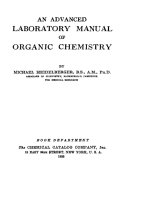advanced laboratory manual of organic chemistry
Bạn đang xem bản rút gọn của tài liệu. Xem và tải ngay bản đầy đủ của tài liệu tại đây (934.09 KB, 103 trang )
AN ADVANCED
LABORATORY MANUAL
or
ORGANIC CHEMISTRY
BY
MICHAEL HEIDELBERGER, B.S., A.M., PH.D.
ASSOCIATE IX CItEMIBTnV, IIOCKEFEIJJ-n INSTITUTE
TOIt MEDICAL IlEflEARCH
BOOK DEPABTMENT
The CHEMICAL CATALOG COMPANY, Inc.
19 EAST
24TH
STREET, NEW YORK, U. S. A.
1923
COPYRIGHT, 1923, BY
The CHEMICAL CATALOG COMPANY, Ino.
All Bighta Reserved
Press of
J, J Uttte
&
Ivos Company
HOT
York, U. S. L.
TO
N.
T.
H.PREFACE.
In the field of organic chemistry there are a number
of elementary laboratory manuals, any one of which
may be used to the student's advantage. When it
comes to the choice of a guide for an advanced course,
however, there is a vast amount of material available
from which a selection in the form of a laboratory
manual has never been made. Hence the student is
often permitted to follow some line in which he is
interested, regardless of its practicability or its value
from the standpoint of training, or else the planning
of the experiments devolves entirely upon the instructor.
With the object of providing a brief advanced course
in manipulative organic chemistry embodying experi-
ments scattered as widely as possible over the important
types of substances and reactions, the author desires
to present this little book in the hope of rendering
simpler the task both of the advanced student and his
instructor.
It has been the writer's aim to select experiments of
greater difficulty than those ordinarily included m ele-
mentary manuals, but to avoid preparations of so diffi-
cult or involved a nature as to become a source of dis-
couragement rather than a stimulus to the student. In
this connection a word of apology may be necessary
for including as much as has been done of the work
of Dr. Walter A. Jacobs of the Rockefeller Institute
and the writer, but it is very strongly felt that the value
of a volume such as the present one depends largely on
the personal experience of its author, and for this rea-
5
6 -PREFACE
son the writer has drawn freely on his own work an
that -of his colleagues. It has been attempted also 1
preserve as just a balance as possible between the chen
istry of aliphatic and aromatic compounds, and to u
elude products of technical and biological, as well \
theoretical importance, in order to provide as broad
foundation as possible for the student in his futui
work. In the selection of experiments, care has bee
taken to exclude those involving great expense, and
further economy is effected by the use of many of tl
initial products as steps in the synthesis of others.
Finally, the author takes great pleasure in acknow
edging his indebtedness to his colleagues at the Rock
feller Institute for Medical Research for the use <
their records in individual experiments, to Prof Ma
ston T Bogert of Columbia University for some ve
pertinent suggestions, and to Prof John 'M Nelson <
Columbia University, whose encouragement and hel
ful advice stimulated the writer to the preparation <
this manual
MICHAEL HEIDELBERGER.
New York City, December, 1922.
TABLE OF CONTENTS
PAGE
PREFACE 5
INTRODUCTORY WARNING n
CHAPTER I. NITRATION AND NITROSATION . 13
A. c^Nitraniline 13
B.
/>-Nitroso-0-cresol 16
CHAPTER II. HALOGENATION 18
A. Chloroacetone 18
B.
dZ-a-Bromopropionic acid 20
C. 5-Iodo-2-toluidine 21
CHAPTER III. SUBSTITUTIONS 23
A. Ethylene cyanohydrin 23
(3-Chloropropionic acid 23
P-Bromopropionic acid 24
B.
Benzylamine 24
C. w-Aminophenol 28
D.
0-Nitrophenylarsonic acid . 29
CHAPTER IV. ESTERIFICATION, ETHERIFICA-
TION, DE-AUCYLATION, AND RELATED REAC-
TIONS 32
A. Methyl Anthranilate 32
B.
p-Nitrophenoxyacetic acid 33
7
8 TABLE OF CONTENTS
PAGE
C. w-Phenetidine 34
D.
Allyl Phenyl Ether and Its Molecular
Rearrangements . . . . 36
1.
Allyl bromide . . 36
2.
Allyl phenyl ether 37
3.
o-Allylphenol . . -37
4.
0-Propenylpheftol . . • 39
5 a-Methylcoumarane 39
E. Dihydrocupreine . . 41
CHAPTER V REDUCTION -45
A. With stannous chloride- p-Ammodi-
methylamline . . 45
B.
With ferrous sulfate and ammonia-
/>-Aminophenoxyacetic acid . . 46
C. With sodium amalgam dl-1
-Phenyl-1-
hydroxy-2-aminoethane . .48
D.
With palladium black. Dihydroqumine 50
CHAPTER VI. OXIDATION , . 54
A. With potassium f erricyanide: jt»-Nitro-
o-cresol . 54
B.
With nitrites: Isonitrosoc&gaphor and
Campj^rqumone 55
C. With aft^ospherk oxygen: Camphoric
acid 58
D.
With bromine
•
Calcium gluconate . . 59
E. With hydrogen peroxide: rf-Arabinose 61
TABLE OF CONTENTS' g
PJ.QH
CHAPTER VII. FORMATION OF HETEROCYCLES
AND DYES . . 64
A. Diethylmalonic ester 64
Diethylbarbitunc acid, "Veronal," "Bar-
bital" 65
B.
9-Methylacndme . 66
C Quinicine (quinotoxine) hydrochloride 6j
D Meldola's blue 70
E Rosindulme . . 71
Rosindone 73
CHAPTER
VIII.
SUGARS, PROTEINS, AND AMINO-
ACIDS 74
A. [3-Glucose 74
(3-Glucose penta-acetate 75
B.
Hydrolysis of a Biose- Galactose from
lactose . 76
C. Preparation of d/-alanine 78
D.
Separation of dZ-alanine into its optical
isomers . . 79
1.
Benzoylation of alanine 80
2.
/-Benzoylalanine 80
3.
Z-Alanine 81
4.
d-Alanine 82
E. Crystalline egg albumin 83
CHAPTER IX. PREPARATION AND REACTIONS OF
ORGANOMETALLIC COMPOUNDS 88
A, Direct arsenatipn of phenol. p-Hydroxy-
pftenylarsonic acid 88
io TABLE OF CONTENTS
PAGE
B.
Synthesis of Salvarsan (Arsphena-
mme),
3,3'-diammo-4,4'-dihydroxyar-
senobenzene dihydrochlonde 92
1.
3-Nitro-4-hydroxyphenylarsomc
acid 92
2 Reduction of the nitro acid . . 93
C. Mercuric compounds of aniline . . 96
1.
/>-Aminophenylmercunc acetate gt
2 />-Mercuri-&«-anilme 9^
INTRODUCTORY WARNING.
The student will remember from his elementary
course that many organic reactions, harmless under con-
trolled conditions, may gather speed and violence if not
carefully watched. Every experiment should therefore
be considered as a whole from the point of view of its
potential sources of danger, and a plan of procedure
mapped out accordingly.
If the reaction is accompanied by a rise of tempera-
ture,
even if no minimum is specified m the directions,
accidents may often be prevented by keeping a pot of
ice water or freezing mixture at hand, into which the
vessel may be plunged in time to prevent boiling over or
decomposition. If gases such as hydrobromic acid, for
example, are evolved, the reaction should be carried out
under the hood, and the vapors led into a flask of water
by a tube terminating above the surface.
Many a weary repetition may also be avoided by
keeping in pots as much as possible large flasks or
beakers containing material on which much time has
been expended.
It should also be kept in mind that most organic
compounds are more or less toxic and many are ex-
tremely dangerous. Distillations other than under
diminished pressure should therefore be carried out
under the hood, and care should be taken to avoid con-
tact of the substances handled with the skin, or inhala-
tion of their vapors or dusts. The writer still has vivid
ii
12 INTRODUCTORY WARNING
recollections of several extremely uncomfortable days
many years ago as a result of getting minute traces of
/\CHBr
2
co-tetrabromo-o-xylene, [ j , on his finger tips
\/CHBr
2
and thence indirectly on his face and into his eyes.
When working therefore with substances which are
known to be irritating the student will find it advisable
to wear rubber gloves. Dried crystalline material or
powders should also be transferred under the hood, a
precaution which it is particularly unsafe to overlook in
the case of the alkaloid, arsenic, and mercury deriva-
tives of which the preparation is described in the fol-
lowing pages.
The student will also frequently handle highly in-
flammable solvents, and must therefore remember that
many painful and even fatal accidents have resulted
from working with these near a flame or electric switch.
While there need be no occasion for timidity, it must
be borne m mind that constant vigilance and concen-
tration are the price that must be paid for the joys, the
satisfaction, and the thrills that come to those who work
in organic chemistry.
AN ADVANCED LABORATORY
MANUAL OF ORGANIC
CHEMISTRY
I. NITRATION AND NITROSATION.
(See also p. 92)
A. Nitration.
o-Nitraniline, o-O
2
NC
a
H
4
NH
fl
.
In the nitration of benzene, it will be remembered,
only one mononitro compound was capable of forma-
tion, and the by-product occurring in the reaction was
w-dinitrobenzene:
NO
2
NO
2
If one substituent ia already present in the benzene
nucleus,
1
however, the case becomes more complicated,
and using aniline or its acetyl derivative as an example,
three fsotineric monotiitro derivatives are theoretically
possible
c
13
14 ADVANCED LABORATORY MANUAL
NHCOCH
3
|NO
2
o-Nitro-acetamlide.
NHCOCH
3
w-Nitro-acetamlide.
JNO,
NHCOCH
a
p-Nitro-acetanilide.
NO
2
The relative amounts of the position isomers formed
vary within wide limits according to the conditions
used, for if one nitrates aniline itself in cold, concen-
trated sulfunc acid a relatively large proportion of
metQr and para- mtranilines are the chief products,
while if acetanilide is nitrated in the same solvent the
para- nitro derivative is obtained almost exclusively.
If the nitration is carried out in an excess of fuming
nitric acid the main product is again the para- com-
pound, with only 6 to 8 per cent of o-nitramline. Witt
and Utermann
1
found, however, that by carrying out
the nitration in glacial acetic acid in the presence of
acetic anhydride as dehydrating agent, about 75 per
cent of the acetanilide nitrated was converted into the
ortho-
compound, the remainder being p-nitro-acetan-
llide.
By this method large amounts of o-nitran-
1
Ber. 39, 3901 (1906), 41, 3090 (1908).
OF ORGANIC CHEMISTRY 15
ihne can readily be prepared. Batches of the size
given below may be conveniently handled in the labora-
tory.
Nitration.
90 g. of acetanihde are dissolved by warming
gently in a mixture of 80 g of acetic anhydride and
44 g. of glacial acetic acid, and the solution is then
chilled in ice-water. 50 g. of fummg nitric acid
(d 1.52) are mixed with 46 g. of glacial acetic acid,
also cooled, and added in small portions to the chilled
acetanilide solution, from which a portion of the
acetanihde may separate. The mixture is stirred well
with a thermometer, adding the nitric acid solution
slowly enough to prevent the temperature from rising
above that of the room, and controlling the speed of the
reaction by immersing in ice-water when necessary.
When the tendency of the temperature to rise becomes
very slight the reaction mixture should be removed
from the ice-water and allowed to stand 24 hours at
room temperature. Care should be taken by cooling
occasionally if necessary during the first hour or two
that the reaction does not become too vigorous. The
next day the mixture is poured on to ice, stirred well,
and the crude crystalline o-nitro-acetamhde filtered off,
washed well with ice-cold water, and sucked as dry as
possible.
Separation of Isomers.
In the meantime a mixture of one volume, of 50 per
cent aqueous potassium hydroxide, 4 volumes of water,
and one volume of alcohol is prepared, cooled to o°,
and the nitration product thoroughly rubbed up (in
portions) in a chilled mortar with about 600 cc. of the
solution. The onitro-acetanilide dissolves, while the
bare*-
compound remains insoluble in the cold mixture
ind is sucked off and washed with a little of the cold
16 ADVANCED LABORATORY MANUAL
solution, then with a little ice-cold water. After re-
crystalhzation from water the yield is 20 g, melting at
207 °.
Saponification.
The filtrate and washings from the crude paro nitro
derivative are now allowed to come to room tempera-
ture,
and on letting stand for 24 hours saponification
occurs and pure o-nitraniline separates in long, orange
red needles, the reaction being as follows:
o-CH
8
CONHC
6
H
4
NO
2
-f H
2
O
>
CH
8
COOH +
HNCHNO
just as acetamide, CH
8
CONH
2
, when warmed with
dilute alkali, splits into acetic acid and ammonia. After
washing with ice-cold water the yield of o-nitraniline is
30-40 g., melting at 71 5
0
.
B.
Nitrosation.
OH
p-Nitroso-o-cresol, 1 j CH
a
.
NO
While the nitrosation of phenols occurs at least as
readily as that of tertiary aromatic amines -such as
dimethylanilme, the conditions must be very carefully
controlled owing to the ease with which most phenols
oxidize. For this reason a higher proportion of tarry
by-products is formed and the yields are smaller than
in the case of the dialkylanilines. Taking o-cresol as
a typical example of a phenol with an unsubstituted
para- position, the main product of the reaction is
^-nitroso-o-cresol«
OF ORGANIC CHEMISTRY 17
54 g. of o-cresol are dissolved in 4 liters of ice-water
in a battery jar provided with an adequate mechanical
stirrer, and 34 5 g of 100 per cent sodium nitrite (or an
equivalent amount of a less pure salt) are then added.
Since nitrosation is effected by means of free nitrous
acid and not its salts no reaction takes place at this
point A solution of 18.5 cc. of concentrated sulfuric
acid in 500 cc. of water is then added through a
dropping funnel during one-half to three-quarters of
an hour, keeping the temperature between 5
0
and io°
by means of additional ice, and stirring continually.
In this way the nitrous acid reacts with the cresol as
fast as liberated to yield the ^-nitroso compound, and
since any local excess of nitrous acid is largely avoided
by the slow addition of the sulfuric acid and the efficient
stirring, the formation of tarry by-products is reduced
to a minimum While the nitroso compound may
separate oily at first, it soon crystallizes. After stand-
ing in the cold for one to two hours after the addition
of the sulfuric acid the mixture is filtered on a large
Buchner funnel and washed with ice-cold water. The
resulting brown solid is purified by dissolving in 10
per cent sodium carbonate solution, stirring with bone-
black to collect insoluble tar, and filtering into an excess
of dilute sulfuric acid. 40-45 g. of the nitroso com->
pound should be obtained in this way as glistening,
orange-brown scales melting at 134
0
.
18 ADVANCED LABORATORY MANUAL
II.
HALOGENATION.
A. Chlorination.
Chloroacetone, C1CH
2
COCH
8
If acetone be treated with a chlorinating agent such
as phosphorus pentachloride, the keto group is at-
tacked and 2,2-dichloro-propane, CH
8
CCl
a
CH
8
, results.
If, however, elementary chlorine is used, the hydrogen
atoms of the methyl groups are successively replaced.
Not only is a mixture of mono- and poly-chlorinated
acetones formed, but the hydrochloric acid liberated
condenses the acetone to products of higher molecular
weight, of which mesityl oxide may be taken as an
example.
CH
8
CH
8
>CO + H
8
CCOCH
8
=> >C .CHCOCH
a
.
CH
8
CH
8
Thus,
unless some substance is at hand to bind the
hydrochloric acid as fast as formed, exceedingly com-
plex mixtures are obtained from which it is virtually
impossible to isolate pure products; mesityl oxide, for
instance, boiling at practically the same point as mono-
chloroacetone. Fritsch
1
found that small pieces of
marble were very satisfactory, as these reacted at once
with the hydrochloric acid liberated, and his method
is accordingly the basis of that given below.
M«« 279, 313 (1894).
OF ORGANIC CHEMISTRY 19
Chlorination.
21 g. of marble, broken into small pieces, and 84 g.
of acetone are placed in a flask provided with an inlet
tube,
dropping funnel, and reflux condenser, and
warmed to 40
0
in a water bath. A slow stream of
chlorine is then passed in and enough water (a total
of 50 to 60 cc. slowly dripped in to keep in solu-
tion the calcium chloride formed by interaction of
the marble and hydrochloric acid This is also aided
by frequent agitation of the flask. The reaction must
be very carefully watched, for if a yellow color develops
(and according to Khng
2
this usually happens at the
lower reaction temperature originally given by Fritsch)
it indicates the formation of hypochlorous acid, and
this,
if it accumulates, may react explosively with the
acetone In the event, then, that the solution turns
yellow the stream of chlorine is at once interrupted
until the coloration disappears. When only a little
marble is left, the reaction is discontinued, for although
a large excess of acetone is present the main product
would be the symmetrical dichloro derivative,
C1CH
2
COCH
2
C1,
if this excess were not maintained.
The mixture is allowed to stand at 40
0
until the evolu-
tion of carbon dioxide ceases, making sure that an ex-
cess of marble is present, and is then poured off from the
marble into a separatory funnel. The two layers formed
are separated and the lower, consisting of a strong
aqueous solution of calcium chloride, is discarded.
Fractionation.
The upper layer of acetone and its chlorination
products is fractionated with the aid of a good distill-
ing column, the monochloroacetone boiling at 118-20
0
.
The yield is 16.8 g., plus an additional 5 g. on refrac-
tionation of the lower and upper fractions.
'Bull, soc chvm. [3] 33, 32a (1905).
20 ADVANCED LABORATORY MANUAL
The chloro-acetones are extremely irritating, both in
vapor form and if dropped on the skin. Gloves should
be worn and all operations conducted under the hood.
This applies to the next experiment as well.
B.
Bromination.
di-a-Bromopropionic Acid, CH
8
CHBrCO
2
H.
The method used depends upon the fact that although
acetic acid and its homologs react with difficulty with
bromine, the anhydrides and acid bromides readily
yield bromo substitution products.
8
Acid Bromide.
To 50 g. of propionic acid and 7.6 g. of dry amor-
phous phosphorus are added, drop by drop, 66 7 g. of
bromine, at about which point evolution of hydro-
bromic acid ceases. Through the intermediate forma-
tion of phosphorus bromides the acid is converted into
the bromide according to the equation (Zehnsky):
4CH
8
CH
2
CO
a
H + P +
5
Br >
4CH
8
CH
s
COBr + PO(OH)
8
+ HBr.
Bromo Acid Bromide.
In order now that substitution should take place it is
unnecessary to isolate the acid bromide—-the mixture
is simply warmed to 40-50
°
on the water bath, using
a reflux condenser, and an additional ip$ & ef bromine
is added drop by drop, the reaction be|%:
CH
a
CH
3
COBr + Br
B
—» CH
8
CHBrCGBr + HBr.
Bromination proceeds rapidly and may be considered
complete two Ijoursi after all of the bromine has been
added, Bromoprogiony! 'bromide boils at 154° under
, Ber. 14, api (1881); VbiSiard, Arm 242, 141 (1887);
, Ber. 20. 2036 (18S7) ; We&fe, Ann. 280, 247 (1894).
OF ORGANIC CHEMISTRY 2\
atmospheric pressure, but distillation of the mixture is
then difficult, and it is accordingly purified by distilla-
tion in a moderate vacuum. The yield is 75-80 per
cent of the theory.
Bromo Acid.
If an ester of a-bromopropionic acid were desired
the appropriate alcohol would now be used, but as the
acid itself is required, the bromide is decomposed by
addition of one and one-third equivalents of water, the
mixture being shaken under a reflux condenser, with a
pot of ice close at hand, until homogeneous, and finally
warmed for one-half hour on the water-bath. The
solution is then cooled, treated with several volumes
of ether, dried over sodium sulfate, and concentrated.
When fractionated in vacuo the residue boils mainly at
124
°
under a pressure of 18-19 mm. and solidifies in
a freezing mixture, then melting at about 25 °. The
acid should be protected from the moisture of the air,
as it is quite hygroscopic. It is also a powerful skin
irritant. The yield should be 60 per cent of the bro-
mide used.
C. Iodination.
5-Iodo-2-toluidine,
CH
8
NH <
0
In general the introduction of iodine into the aro-
matic nucleus is not as readily effected as in the case of
chlonne or bromine, butarornaticamines unsubstitutedin
the paro- position nevertheless react easily with iodme.
*
Wheeler and Liddle, Am. Chem. I. 4a, 501 (igog).
22 ADVANCED LABORATORY MANUAL
An equimolecular amount of iodine is dissolved in
o-toluidine, substitution taking place with evolution of
heat and conversion of one-half of the base into the
hydnodide, according to the equation:
2CH
8
C
a
H
4
NH
2
+ I
2
>
I(CH
8
)C
a
H
8
NH
2
+ CH
8
C
6
H,NH
a
.HI.
In order to utilize the remainder of the o-toluidine and
iodine the reaction is completed by heating the mixture
under a reflux condenser with an equal volume of
water, 2 molecular equivalents of powdered calcium
carbonate, and 2 volumes of ether to take up the iodo
base formed, the entire reaction being represented by
2 + 2l
2
+ CaCO
8
>
2l(CH
3
)C
e
H
8
NH
2
+ Cal
a
+ CO
2
+ H
a
O.
After one hour's heating the ether is allowed to boil off
and the mixture is distilled with steam, the iodo com-
pound passing over slowly m a yield of 75 per cent of
the theory. The practically pure product is dried and
recrystallized from ligroin, forming prisms which melt
at 90-1 °.
OF ORGANIC CHEMISTRY 23
III.
SUBSTITUTIONS.
A. (3-Chloropropionic Acid.
1.
Ethylene Cyanohydrin, aa
32 g of ethylene chlorohydnn, C1CH
2
CH
2
OH, are
dissolved in 160 cc of absolute alcohol and boiled under
a reflux condenser To the boiling liquid is added,
drop by drop, a solution of 27.2 g. of potassium cyanide
in 42 cc of water, and the boiling continued for 8-10
hours.
A precipitate of potassium chloride forms, and
at the end this is filtered off, washed with a little alcohol,
and the filtrate concentrated to a syrup and fractionated
m vacuo. The yield of cyanohydrin should be 20 g.,
boiling at uo° under 15 mm pressure.
2.
p-Chloropropionic Acid, C1CH
2
CH
2
CO
2
H.
10 g. of ethylene cyanohydrin are heated in sealed
tubes at ioo° with 75 cc. of concentrated hydrochloric
acid for three hours If the cyanohydrin is boiled with
dilute sodium hydroxide
2
or warmed with acid in
dilute alcohol,
8
hydrolysis of the mtnle or CN group
occurs,
HOCH
a
CH
8
CN -f 3H
2
O »
HOCH
2
CH
2
COOH + NH<OH,
and the so-called hydracrylic acid is formed, among
other products. If, on the other hand, the cyanohydrin
a
Moureu, Bull, soc chim [3] g, 426 (1893); Jacobs and
Heidelberger, J. Am. Chem Soc 39, 1465 (1917),
•Wislicenus, Ann 128, 6 (1863)
•Erlenmeyer, Ann. 191, 268 (1878),
24 ADVANCED LABORATORY MANUAL
is heated in a sealed tube with concentrated hydro-
chloric acid, not only is the nitrile group saponified to
carboxyl, but chlorine replaces the hydroxyl group,*
the end result being
HOCH
2
CH
2
CN + 2HCI + H
2
O >
C1CH
2
CH
2
COOH +
NH<C1.
There is no evidence at hand as to whether the inter-
mediate product is hydracrylic acid or ClCHjCH
2
CN,
or both, although it is known that [3-chloropropionic
acid can be prepared from the former."
The contents of the tubes are diluted with just
enough water to dissolve the ammonium chloride
which has separated and extracted repeatedly with
ether, thorough extraction being necessary, as the
chloropropionic acid is also quite soluble in water.
After drying the ethereal extracts over anhydrous
sodium sulfate and concentrating, a syrupy residue is
left, which crystallizes readily on cooling and rubbing
with a rod The yield should be 10.5 g. Recrystallized
from ligroin, it melts at 38.5-9 5
0
(corr.).
Similarly 10 g. of ethylene cyanohydrin, boiled three
hours with 100 cc. of hydrobromic acid (d 1.49) and
worked up in the same way, yield 17 g. of (3-bromo-
propionic acid, melting at 60-1 ° (corr.) after recrys-
tallization from ligroin.
B.
Benzylamine, C
6
H
5
CH
2
NH
8
.
Benzylhexamethylenetetraminium Chloride.
70 g. of benzyl chloride are added to a suspension
of 70 g. of finely powdered hexamethylenetetr«»mine in
4 parts of chloroform, heated to boiling under ^ reflux
condenser on the water bath, and removed if necessary
*
Jacobs and Heidelberger, loc. cit.
"Beckurts and Otto, Ber, 18, 236 (1885).
OF ORGANIC CHEMISTRY 25
until the initially often vigorous reaction is over. The
mixture is then heated one-half hour longer, placing
the flask on a cork or rubber ring to protect it from
the bumping which usually occurs
This method, of course, is an indirect one for replac-
ing the halogen of benzyl chloride by ammonia. If
ammonia itself is used, the usual mixture of primary,
secondary, and tertiary bases is formed, and the yield
of primary benzylamine is poor. Dele"pine
6
found,
however, that the primary amme was the main product
if benzyl chloride was first combined with hexameth-
ylenetetramine and the resulting compound suitably
decomposed As the method is of wide application for
the preparation of primary amines it is given here.
As is well known, formaldehyde and ammonia com-
bine to yield hexamethylenetetramine, C
0
H
ia
N
4
. Duden
and
Scharff
7
found that most of the reactions of this
substance could be explained on the basis of the three
dimensional formula.
Among its other properties, hexamethylenetetramine
combines with one molecular equivalent of an aliphatic
8
Del6piri«, Bull soc. chim. [3] 17, 393 (1897).
T
Pydc8 and
Scharff,
Am. a88, 218 (1895).
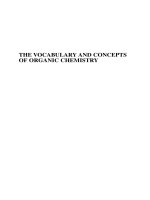
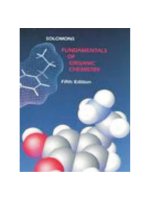

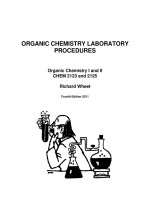
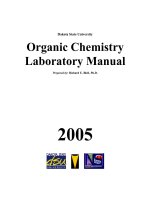
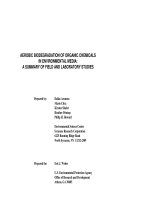
![dyker - handbook of c-h transformations [organic chemistry] (wiley, 2005)](https://media.store123doc.com/images/document/14/ri/ah/medium_eZ1VrCiIJB.jpg)

